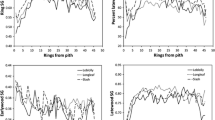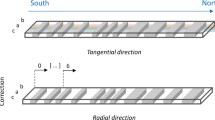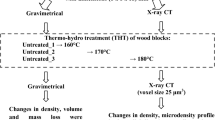Abstract
Two computed tomography scanners have been used to acquire density profiles from five wooden test pieces. These test pieces had annual growth ring widths varying between about 0.6 mm and 3.5 mm. The two scanners employed were a medical scanner, a GE 9800 Quick scan system, and a purpose built microscanner constructed around a Rigaku D-Max II diffractometer. The results demonstrated that the annual growth rings could be resolved and density measurements could be reliably determined using the microscanner when the annual growth rings were about 0.9 mm or greater in width. The medical scanner could not satisfactorily measure density in carlywood or latewood resions even in samples where the annual growth ring width was of the order of 3.5 mm. A small difference in density measurements could be observed between the two scanners for the same specimens. The difference is attributed to calibration differences, the reconstruction algorithms used and the different geometries of the two systems; particularly in relation to the detector apertures. The larger detector size in the medical system results in too high or too low density values in the carlywood or the latewood respectively due to spatial averaging. However, the medical scanner provides satisfactory density accuracy in specimens where the density is very uniform or as long as measured areas include both carlywood and latewood. An accuracy of ±2–6 kg/m3 at 95% confidence level can then be expected.
Zusammenfassung
Zwei Computer-Tomographen, ein Klinik-Scanner und ein selbstgebauter Mikroscanner, wurden benutzt, um Dichteprofile von fünf Holzproben aufzunehmen. Die Breite der Jahresringe variierte zwischen 0,6 und 3,5 mm. Die Ergebnisse zeigten, daß die Jahresringabfolge mit dem Microscanner augelöst und die Dichte verläßlich bestimmt werden kann, wenn die Ringbreite nicht kleiner als 0,9 mm beträgt. Der Klinik-Scanner erbrachte keine zufriedenstellende Auflösung, auch nicht bei Jahresringbreiten um 3,5 mm. Beide Scanner lieferten leicht unterschiedliche Dichtewerte. Die Differenzen werden auf unterschiedliche Kalibrierung und Software sowie auf die unterschiedliche Meßgeometrie speziell der Detektor-Apertur der beiden Systeme zurückgeführt. Die große Detektor-Apertur des Klinik-Scanners verursachte bei Frühholz zu hohe, bei Spätholz zu niedrige Dichtewerte, weil zu große Meßbereiche gemittelt werden. An Proben mit sehr gleichmäßiger Dichteverteilung oder bei gleichzeitigem Erfassen von Früh- und Spätholz liefert auch der Klinik-Scanner zufriedenstellende Werte der Holzdichte. Eine Genauigkeit von ±2,6 kg/m3 im Vertrauensbereich von 95% kann erwartet werden.
Similar content being viewed by others
References
Cormack, A. M.: Representation of a Function by its Line Integrals with some Radiological Applications. J. Appl. Phys. 34 (1963) 2722
Herman, G. T.: Image Reconstruction from Projections—The Fundamentals of Computerized Tomography. Academic Press, NY 1980
Hattori, Y. and Kanagawa, Y.: Non-Destructive Measurement of Moisture Distribution in Wood with a Medical CT-scanner. Journal of the Japan Wood Research Society 31(12) (1985) 974–982
Hounsfield, G. N.: Computerized Transverse Axial Scanning Tomography. Br. J. Radiol. 46 (1973) 1016
Jackson, D.F. and Hawkes, D. J.: X-ray Attenuation Coefficients of Elements and Mixtures. Physics Reports 70(3) (1981) 169–233
Levi, C., Gray, J. E., McCullough, E. C. and Hattery, R. R.: The Unreliability of CT-numbers as absolute values. AJR, 139 (1982) 443–447
Lindgren, L. O.: Non-Destructive Measurements of Density and Moisture Content in Wood Using Computerized Tomography. Tech Lic Thesis Royal Inst. of Technology, Stockholm (in Swedish) 1988
Mull, R.: Mass Estimates by Computed Tomography. Physical Densities from CT-numbers. AJR, 143 (1984) 1101–1104
Ramachandran, G. N. and Lakshminarayanan, A. V.: Three Dimensional Reconstruction from Radiographs and Electron Micrographs: Applications of Convolutions instead of Fourier Transforms. Proc. Nat. Acad. Sci., USA, 68 (1971) 2236–2240
Wells, P., Suendermann, B., Davis, J. R., Shadbolt, P. A. and Morgan, M. J., An Inexpensive X-ray Microtomography Instrument. Internal report at the Dept of Applied Physics, Chisholm Institute of Technology, Caulfield Campus, Melbourne, Australia 1989
Author information
Authors and Affiliations
Additional information
A correction to this article is available at http://dx.doi.org/10.1007/BF02628637
Rights and permissions
About this article
Cite this article
Lindgren, O., Davis, J., Wells, P. et al. Non-destructive wood density distribution measurements using computed tomography. Holz als Roh-und Werkstoff 50, 295–299 (1992). https://doi.org/10.1007/BF02615356
Published:
Issue Date:
DOI: https://doi.org/10.1007/BF02615356




